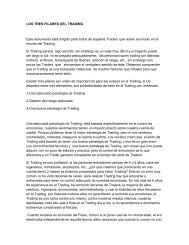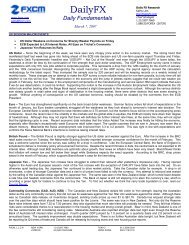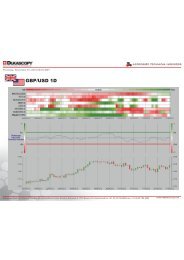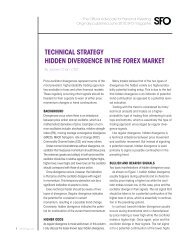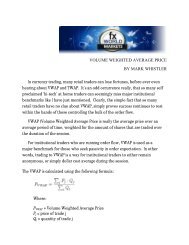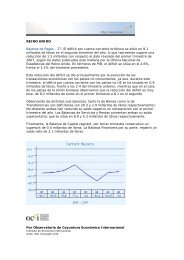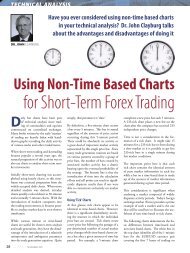Swing Trading Techniques (pdf) - Forex for Beginners
Swing Trading Techniques (pdf) - Forex for Beginners
Swing Trading Techniques (pdf) - Forex for Beginners
You also want an ePaper? Increase the reach of your titles
YUMPU automatically turns print PDFs into web optimized ePapers that Google loves.
Another Pitfall of Trend <strong>Trading</strong> – Inefficient Use of<br />
Capital<br />
Another problem that the trend trader faces is the inefficient use of<br />
trading capital. While markets ‘tend to trend,’ there are long periods<br />
when they are stuck in trading ranges effectively going nowhere. By<br />
definition, the trend trader has to sit through these corrections waiting<br />
<strong>for</strong> the trend to resume with trading capital tied up limiting opportunities<br />
that may arise elsewhere.<br />
Solution – Timing Trend Entry and Exit<br />
The solution to this problem is to time the market so that<br />
trading capital is not constantly tied up. In an uptrend, this<br />
would involve buying near a corrective low and exiting near<br />
a swing high, but this strategy can have its own drawbacks.<br />
When a correction begins, no one is sure how far it will go<br />
or how long it will last.<br />
Technicians use percentage retracements (<strong>for</strong> example –<br />
Fibonacci) in an ef<strong>for</strong>t to gauge where a correction should<br />
end, but no hard and fast rules exist except perhaps <strong>for</strong> the<br />
Dow theory rule that retracements should be limited to 2/3<br />
of the previous swing. If the 2/3 level is breached, the trend<br />
has probably changed direction.<br />
<strong>Swing</strong> <strong>Trading</strong> – A More Flexible and Surgical Approach<br />
This brings me to the swing trading approach that I believe<br />
to be more flexible and surgical than trend trading.<br />
The objective of the swing trader is not to jump on a trend<br />
and ride it through all of the corrections as a trend trader. A<br />
swing trader tries to capture those explosive 2 to 4 bar price<br />
swings that are so common. Many of the trades a swing<br />
trader takes will be in the direction of the trend, but some<br />
will be counter-trend. The swing trader is more concerned<br />
with price momentum than trend, looking <strong>for</strong> the path of<br />
least resistance at any given time.<br />
Are there conditions that make an explosive price<br />
move likely?<br />
I believe there are and I aim to demonstrate why I think this<br />
occurs. The trading set-ups I am about to show you are<br />
based on my theory that many of these explosive moves<br />
occur as the result of false breaks of support and/or resistance.<br />
It seems that <strong>for</strong> a market to make a large move in a<br />
given direction, a significant number of traders must be<br />
incorrectly positioned. Bulls and bears need to be fed and<br />
the fresh meat they consume comes from vulnerable<br />
traders!<br />
<strong>Trading</strong> Rules<br />
What trading rules could be employed to benefit from these<br />
market traps? How do we know when a Bull or Bear Trap<br />
has been sprung? Let’s consider the Bear Trap buy signal<br />
and two of the entry triggers I use.<br />
TRAPPED!<br />
Introducing the Bull and Bear Trap!<br />
When a support level such as a swing low is breached, the market often attracts fresh<br />
interest from both buyers and sellers. The ‘buy low’ crowd come in looking <strong>for</strong> value at<br />
previously cheap levels, while the breakout/trend following crowd sell the breakout looking<br />
<strong>for</strong> an extension of the decline. If the downside break fails to see follow-through selling,<br />
frustrated short sellers cover their positions bidding the market up creating a<br />
whipsaw. The market advance is exacerbated by the ‘wait and see’ crowd who come in<br />
after most of the cards have been played, and the ‘buy low’ crowd who add to their<br />
longs having been rewarded <strong>for</strong> their bravery in resisting the downside break. The resulting<br />
rally often lasts <strong>for</strong> several price bars, presenting a lucrative trading opportunity <strong>for</strong><br />
the swing trader.<br />
Graphic illustration of the Bear Trap (reverse criteria <strong>for</strong> Bull Trap)<br />
Here are some examples of the Bull and Bear Trap in action:<br />
EUR/USD daily chart<br />
S&P 500 Weekly chart<br />
EUR/JPY Monthly chart<br />
TEXT HOWARD FRIEND<br />
DECEMBER 2009 The <strong>Forex</strong> Journal 25<br />
SOURCE BLOOMBERG FINANCE LP



![Hedge [Modo de compatibilidad] - FXstreet.com](https://img.yumpu.com/17927360/1/190x135/hedge-modo-de-compatibilidad-fxstreetcom.jpg?quality=85)
